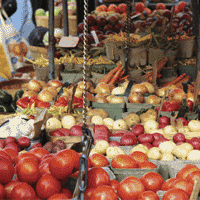With restaurants on board, the local-food movement looks for new converts
When chef Michael Potters moved to rural Prince Edward County in 2003, the word local meant the local store. Instead of ordering food from Toronto, he chose to work with County farmers whose names now grace his menu at the 45-seat Angeline’s restaurant in Picton, Ont.
“We started out of necessity, and it grew into a passion,” says Potters, whose cooks feed Rosie the pig and collect eggs for guests’ breakfast from the restaurant’s new hens. “There’s a story behind every pepper, every eggplant and every carrot we use,” he says. “That story is important for us and for our customers. The farmers are the stars — I just cook.”
Potters’ story echoes across the province, where an increasing number of restaurants are building relationships with growers.
Rory Golden, executive chef at Deerhurst Resort in Muskoka, another local pioneer, is looking forward to serving salads in his restaurants this summer accompanied by a tiny pot of living sprouts, grown exclusively r the resort, and a pair of scissors so guests can snip their own fresh garnish.
Golden says prompt delivery and consistent quality are his biggest local challenges, and there’s extra prep required as his cooks sort through containers from different growers, the only way he can gather the quantities he needs. “We’re always adjusting who we’re going to be using for that week,” he says. But he enjoys the challenge. “Someone can knock on our door with 50 pounds of wild watercress and we’ll have a place for it.”
Local has also become a marketing tool, Golden says, as more meeting planners request locally grown ingredients for banquets of 400 to 500. Some are harvested on the resort’s 760 acres; these include maple syrup, honey, wild mushrooms, shiitakes grown on logs and cattails for a crunchy salad. But if he can’t get a local tomato, he tells organizers, he may have to look across the province or across Canada. He also finds today’s diners are more accepting when told why they’re getting whitefish instead of rainbow trout. “They seem to understand more about the seasons and the market.”
With the help of government grants, schools and seniors’ homes may be the next frontier for the local movement. In September, when Ontario schools implement the province’s new healthy eating strategy in cafeterias and vending machines, the Peel District School Board west of Toronto will be going one step further. Working with the non-profit environmental group EcoSource, Peel Public Health and Chartwells — a division of Compass Group Canada which runs most of the Board’s cafeterias — intend to serve as much local food as possible to some 150,000 students.
As a first step, Compass conducted an audit to determine how much Ontario-produced food it currently purchases and how to increase that amount. “Produce is the easy one,” says Ross Munroe, president of Chartwells. “You know an apple grown around the corner is a local apple, but acan of tomato sauce is more of a challenge. We can say bakery products are local, but where did the flour come from? It’s an interesting process, and we’re anxious to be accurate with our numbers.”
Finding growers big enough to fill Chartwells’ order is another challenge. “Some farmers say if they supply us they can’t supply their own locals,” Munroe says,“ so we’re expanding the number of farms we work with.”
But simply offering local menu options, such as Chartwells’ new turkey sausage and pepperoni, is no guarantee students will buy into them, says Lea Ann Mallet, executive director of Mississauga-based EcoSource. “When it comes to big food changes, if students aren’t involved and don’t feel they’re part of that change, they end up walking out of the cafeteria and going to the closest fast-food operation.”
To encourage involvement, the Peel Board challenged 34 student teams to create a healthy dish featuring Ontario-grown products. The winning recipe, chosen in a cook-off in May, will be served in Peel cafeterias in September. EcoSource is also conducting student focus groups and surveys, and taste tests of local produce will be set up outside cafeterias.
Meanwhile, at St. Joseph’s Health Centre in Guelph, Ont., Leslie Carson, food and nutrition services manager, is conducting a local food audit. She believes locally sourced food not only benefits the economy, but is the safest way to feed her 331 elderly long-term care and hospital patients.
“In today’s environment, here food sensitivities are increasing, it’s a headache trying to identify what’s in processed food,” Carson says. “Most of our clients are farmers and Italians from a rural area. The simple food we serve appeals to them but might not work in downtown Toronto.”
A local distributor sends Carson a weekly list of what’s available. The dietitian also buys homestyle bread from a Portuguese bakery and hormone-free meats from Guelph-based Rowe Farms.“Often these items are more expensive,” she says,“ but we find the loss is significantly less and most elderly patients benefit from small portions. Our menu is based on quality versus quantity.”
At St. Joseph’s, everyone gets the same meal, Carson notes. “If we’re making stew or beef stroganoff, that’s what the EO and Board of Directors will be eating.” Cooking from scratch and getting positive feedback gives the staff a sense of pride, she says. “When you’re unloading a box of frozen lasagna, there’s not that sense of pride and growth,” she says. “We hope our program will help change food procurement practices throughout the health-care system.”
Ontario Fresh
Finding Ontario-produced food is about to get easier with the launch of Ontariofresh.ca. Growers, producers, chefs, caterers, distributors and organizations that care about local food are invited to submit a profile in preparation for the site’s launch in September. “It’s going to be a great way for chefs to find sources for local food quickly and easily,” says Allison Decker, communications manager for Toronto-based Friends of the Greenbelt Foundation. Through the site, growers looking for buyers will be able to post information about their crop, Decker says, and interested buyers can check the grower’s profile to make direct contact. Chefs looking for a particular product can also post their request online. To join, visit ontariofresh.ca. For questions, contact [email protected].





















